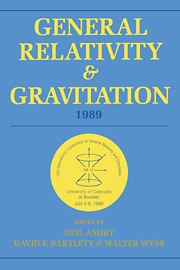 General Relativity and Gravitation, 1989
General Relativity and Gravitation, 1989 Book contents
- Frontmatter
- Contents
- Preface
- Conference committees
- Part A Classical relativity and gravitation theory
- 1 Colliding waves in general relativity
- 2 How fast can pulsars spin?
- 3 Global properties of solutions to Einstein's equations
- 4 Progress in 3D numerical relativity
- WORKSHOPS
- Part B Relativistic astrophysics, early universe, and classical cosmology
- WORKSHOPS
- Part C Experimental gravitation and gravitational wave detection
- WORKSHOPS
- Part D Quantum gravity, superstrings, quantum cosmology
- WORKSHOPS
- Part E Overviews-past, present, and future
4 - Progress in 3D numerical relativity
Published online by Cambridge University Press: 05 March 2012
- Frontmatter
- Contents
- Preface
- Conference committees
- Part A Classical relativity and gravitation theory
- 1 Colliding waves in general relativity
- 2 How fast can pulsars spin?
- 3 Global properties of solutions to Einstein's equations
- 4 Progress in 3D numerical relativity
- WORKSHOPS
- Part B Relativistic astrophysics, early universe, and classical cosmology
- WORKSHOPS
- Part C Experimental gravitation and gravitational wave detection
- WORKSHOPS
- Part D Quantum gravity, superstrings, quantum cosmology
- WORKSHOPS
- Part E Overviews-past, present, and future
Summary
Inflationary supercomputing
There are many problems in numerical relativity. From a view point of asymptotic behavior of space-times they are divided into three categories as:
V: Vacuum space-times;
AF: Asymptotically flat space-times with matter;
ANF: Asymptotically non-flat space-times with matter.
On the other hand from a view point of dimension of the problem they are divided into another three categories as:
ID: A problem in which all the physical quantities depend on one spatial coordinate x1 and the time t;
2D: A problem in which all the physical quantities depend on two spatial coordinates x1 and x2 and the time t;
3D: A problem in which all the physical quantities depend on three spatial coordinates x1, x2 and x3 and the time t.
Every problem can be characterized according to these two classifications. For example, the two black hole collision calculated by Smarr belongs to V-2D. There are also many numerical methods for each problem. They include the characteristic method, Regge calculus, finite element method, finite difference method, spectral method, particle method and so on. Moreover the choice of coordinate conditions is not usually unique for each method. Therefore there are a tremendous variety of possibilities for each author's problem. In reality there are up to 30 papers on numerical relativity in this conference which are reviewed by Centrella in this volume.
One of the main factors, however, which determines progress in numerical relativity is the power of available computers.
- Type
- Chapter
- Information
- General Relativity and Gravitation, 1989Proceedings of the 12th International Conference on General Relativity and Gravitation, pp. 61 - 84Publisher: Cambridge University PressPrint publication year: 1990


